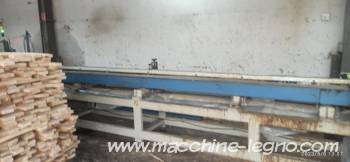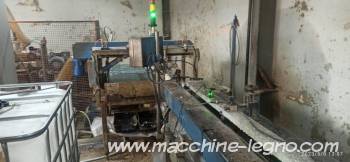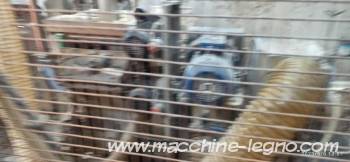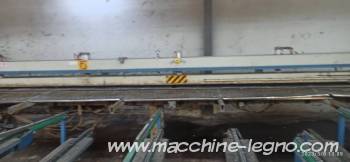The PDFD line consists of two basic components: the DFC 60 milling-tenoning machine socket (where the faces of the slats are machined) and the PHSL length joining press, on which the elements are connected into a slat up to 6.6 m long with the possibility of programming up to eight cuts dividing the strip into segments of the length programmed by the operator. Between these basic devices, there are transport devices that also perform the function of initial tenoning. The presented configuration of the line makes it possible to obtain a capacity of approx. 8,000 m/shift.
The microprocessor control system allows flexible adjustment of operating parameters to the user's needs. The presented machine has the ability to process elements of the "calzing" type as well as elements for the production of countertops (joined "on a line"). The use of a receiving table with automatic feeding of slats to the infeed conveyor of the PHSL press enables the line to be operated by one employee feeding the elements. The receiving table is equipped with a buffering screen that increases efficiency and smoothness of work. The line works in an automatic cycle with manual material feeding. The components of the line can be assembled in various (agreed with the recipient) configurations enabling the machine to be adapted to the user's premises.
Width of glued elements mm 30 ÷ 155
Length of glued elements mm 170 ÷ 900
Thickness of glued elements mm 20 ÷ 70
Air working pressure MPa 0.6
Compressed air demand m3/h approx. 25
Working capacity cycle./min. up to 4 (6600 strip)
The length of the glued element mm 4500 ÷ 6600
Operating voltage V AC 3/N/PE 400 V 50 Hz
Control voltage V DC 24
Power demand kW max 100
The wooden slats are fed by the operator onto the cart of the first milling and tenoning machine. Specifying elements initiates the work cycle of milling machines. On the first milling machine, the fronts of the package are aligned and then the outline of the dovetail is milled. The package is fed to the table of the second milling and tenoning machine, where the other side of the package is processed and the glue is applied.
Elements fed from the DFC - 60 D tenoning machine through a chain conveyor are fed into the preliminary tenoning unit, where, with the use of a set of shafts and a presser, the initial clamping of the square timber wedge joint is made before entering the press.
Pre-pinned square timber is directed to the press table, where, after reaching the required length, they are cut. Then, with the help of the pushing bar and the pressing bar, they are moved to the area of the pressure bed, where the pressing process takes place. The glued and pressed, ready strip is pushed to the receiving table of the press.
After moving the square timber to the area of the pressure bed, the process of feeding the elements to the press table takes place in parallel with the activities described above. This keeps the press running continuously and thus allows for increased gluing capacity.
- Poland
- Usate










































